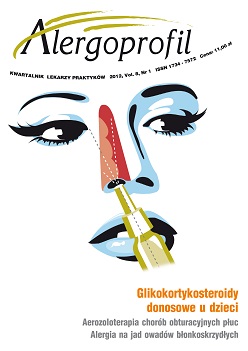Dynamika sezonów pyłkowych wybranych drzew i roślin zielnych w Szczecinie – 2011 r.
##plugins.themes.bootstrap3.article.main##
Abstrakt
Celem pracy było przedstawienie dynamiki sezonów pyłkowych wybranych taksonów (Corylus, Alnus, Populus, Ulmus, Fraxinus, Betula, Carpinus, Quercus, Platanus, Pinaceae, Poaceae, Rumex, Plantago, Chenopodiaceae, Urtica, Artemisia oraz Ambrosia) w Szczecinie w 2011 r. Pomiary stężenia pyłku prowadzono metodą objętościową z zastosowaniem aparatu Hirsta (model Lanzoni 2000). Sezon pyłkowy wyznaczono jako okres, w którym w powietrzu występuje 98% rocznej sumy ziaren pyłku. Do opisu dynamiki sezonów obliczono indeks pyłkowy SPI oraz wyznaczono poszczególne fazy okresów pyłkowych, dla których skumulowana suma pyłku osiąga wartości: 1–5%, 5–25%, 25–50%, 50%, 50–75%, 75–95% oraz 95–99% całkowitej sumy rocznej pyłku. Analiza czasu trwania poszczególnych fenofaz wykazała większe zróżnicowanie dynamiki sezonów w odniesieniu do drzew i krzewów niż do roślin zielnych. Do najistotniejszych czynników wpływających na stężenie pyłku roślin w powietrzu należą: maksymalna prędkość wiatru, temperatura maksymalna powietrza, wilgotność i temperatura punktu rosy. Zanotowane korelacje pomiędzy koncentracją pyłku analizowanych taksonów a zanieczyszczeniami powietrza są wynikiem oddziaływania czynników pogodowych na obie grupy zmiennych.
Pobrania
##plugins.themes.bootstrap3.article.details##
Copyright: © Medical Education sp. z o.o. This is an Open Access article distributed under the terms of the Attribution-NonCommercial 4.0 International (CC BY-NC 4.0). License (https://creativecommons.org/licenses/by-nc/4.0/), allowing third parties to copy and redistribute the material in any medium or format and to remix, transform, and build upon the material, provided the original work is properly cited and states its license.
Address reprint requests to: Medical Education, Marcin Kuźma (marcin.kuzma@mededu.pl)
Bibliografia
2. Docampo S., Recio M., Trigo M.M., Melgar M., Cabesudo B.: Risk of pollen allergy in Nerja (southern Spain): a pollen calendar. Aerobiologia 2007, 23: 189-199.
3. Driessen M.N.B.M., van Herpen R.M.A., Smithuis L.O.M.J.: Prediction of the start of the grass pollen season of the southern part of the Natherlands. Grana 1990, 29: 79-86.
4. Emberlin J., Smith M., Close R., Adams-Groom B.: Changes in the seasons of the early flowering trees Alnus spp. and Corylus spp. in Worcester, United Kingdom, 1996-2005. Int. J. Biometeorol. 2007, 51: 181-191.
5. Frenz D.A.: Interpreting atmospheric pollen count for use in clinical allergy: spatial variability. Ann. Allergy Asthma, Immunol. 2000, 84: 481-491.
6. Gniazdowski R., Klimas F.: Wykorzystanie obserwacji palynologicznych i fenologicznych w ustalaniu szczegółowej etiologii pyłkowicy. Otolaryngologia Polska 1976, 30: 21-27.
7. Jaeger S.: Long term trends of pollen seasons in Europe: Changes in start, duration and intensity. Anstracts, 7th Int. Congress on Aerobiology, Montebello, Canada 2002, 5-9 August: 12-13.
8. Kadocsa E., Juhasz M.: Study of airborne pollen composition and allergen spectrum of hay fever patients in South Hungary (1990-1999). Aerobiologia 2002, 18: 203-209.
9. Kasprzyk I.: Regional differentiation in the dynamics of the pollen season of Alnus, Corylus, and Fraxinus in Poland (preliminary results), Aerobiologia 2004, 20: 141-151.
10. Latałowa M., Miętus M., Urska A.: Seasonal variations in the atmospheric Betula pollen count in Gdansk (Southern Baltic coast) in relation to meteorological parameters. Aerobiologia 2002, 18: 33-43.
11. Mandrioli P., Comtois P., Dominguez E., Galan C., Isard S., Syzdek L.: Sampling: Principles and Techniques. W: Methods in Aerobiology. Mandrioli P., Comtois P., Levizzani V. (red.). Pitagora Editrice Bologna, Bologna 1998: 47-112.
12. Obtułowicz K.: Alergologia ogólna. W: Alergologia praktyczna. Obtułowicz K. (red.). PZWL, Warszawa 2001: 17-56.
13. Pałczyński C., Witczak T.: Warunki mieszkaniowe a rozwój astmy dziecięcej. W: Astma dziecięca. Wybrane zagadnienia. Stelmach I. (red.). PZWL, Warszawa 2007: 91-99.
14. Puc M.: Threat of allergenic airborne grass pollen in Szczecin, NW Poland: the dynamics of pollen seasons, effect of meteorological variables and air pollution. Aerobiologia 2011, 27: 191-202.
15. Parrado A.G., Barrera R.M.V., Rodriguez C.R.F., Maray A.M.V., Romero R.P., Fraile R., Gonzales D.F.: Alternative statistical methods for interpreting airborne Alder (Alnus glutinosa (L.) Gaertner) pollen concentrations. Int. J. Biometeorol. 2009, 53: 1-9.
16. Rodriguez-Rajo J., Gonzalez M.D., Maray A.V., Suarez F.J., Barrera R.M., Jato V.: Biometeorological characterization of the winter in the north-west Spain based on Alnus pollen flowering. Grana 2006, 45: 288-296.
17. Rogerieux F., Godfrin D., Sènèchal H., Motta A.C., Marlière M., Peltre G. et al.: Modifications of Phleum pretense Grass Pollen Allergens following Artificial Exposure to Gaseous Air Pollutants (O3, NO2, SO2). Allergy and Immunology 2007, 143: 127-134.
18. Saar M., Gudžinskas Z., Ploompuu T., Linno E., Minkienė Z., Motiekaitytė V.: Ragweed plants and airborne pollen in the Baltic states. Aerobiologia 2000, 16: 101-106.
19. StatSoft, Inc. STATISTICA (data analysis software system), version 9.0. 2008 [online: www.statsoft.com].
20. Stennet P.J., Beggs J.: Pollen in the atmosphere of Sydney, Australia, and relationships with meteorological parameters. Grana 2004, 42: 209-216.
21. Szczepanek K.: Pollen calendar for Cracow (South Poland) 1982–1991. Aerobiologia 1994, 10: 65-75.
22. Śpiewak R., Skórska C., Prażmo Z., Dutkiewicz J.: Bacterial endotoxin associated with pollen as a potential factor aggravating pollinosis. Ann. Agric. Environ. Med. 1996, 3: 57-59.

